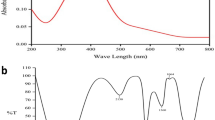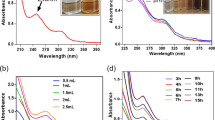Abstract
Pristine and 2 % silver-doped indium oxide (In2O3) nanoparticles, synthesized by solution combustion method, yielded spherical nanoparticles in the range of 20–30 nm. The nanoparticles were stabilized in cubic bixbyite structure as revealed from X-ray diffraction study. In order to evaluate the potential of these nanoparticles to modulate enzyme activity, α-amylase and α-glucosidase were used as model enzymes. Pristine and 2 % silver-doped In2O3 nanoparticles demonstrated dose-dependent inhibition of α-amylase and α-glucosidase activities. Pristine In2O3 nanoparticles demonstrated 26.4 % (300 µg/mL) and 65.3 % (300 µg/mL) inhibition against α-amylase and α-glucosidase, respectively. In contrast, silver-doped In2O3 nanoparticles depicted 94.1 % (300 µg/mL) and 99.6 % (0.18 µg/mL) inhibition against α-amylase and α-glucosidase, respectively. In comparison with acarbose, a standard anti-diabetic drug that depicted absolute inhibition of α-glucosidase activity at 300 µg/mL, 2 % silver-doped In2O3 nanoparticles completely inhibited α-glucosidase at a very low concentration (0.18 µg/mL). In view of our results, the activity of α-amylase and α-glucosidase, which are targets for treatment of type 2 diabetes, can be modulated using silver-doped In2O3 nanoparticles in the concentration-dependent manner. Therefore, silver-doped In2O3 has a potential to be used as a prospective starch blocker.








Similar content being viewed by others
References
Bagheri-Mohagheghi MM, Shahtahmasebi N, Mozafari E, Shokooh-Saremi M (2009) Effect of the synthesis route on the structural properties and shape of the indium oxide (In2O3) nano-particles. Phys E 41:1757–1762
Chandradass J, Bae DS, Kim KH (2011) A simple method to prepare indium oxide nanoparticles: structural, microstructural and magnetic properties. Adv Powder Technol 22:370–374
Cho ML, Han JH, You SG (2011) Inhibitory effects of fucan sulfates on enzymatic hydrolysis of starch. LWT Food Sci Technol 44(4):1164–1171
De M, Chou SS, Dravid VP (2011) Graphene oxide as an enzyme inhibitor: modulation of activity of α-chymotrypsin. J Am Chem Soc 133(44):17524–17527
Dhobale S, Thite T, Laware SL, Rode CV, Koppikar SJ, Ghanekar RK, Kale SN (2008) Zinc oxide nanoparticles as novel α-amylase inhibitors. J Appl Phys 104(9):094907
Di SA, Mordas C J, Nikolovski J, Wiegand BC (2007) Metal coated nanoparticles for use in the treatment of enzymatic dermatitis. Publication no.: EP2083796 B1, Filing date: Oct 26, Publication date: 16 Mar 2011 (Patent)
El-Gendy AA, Ibrahim EMM, Khavrus VO, Krupskaya Y, Hampel S, Leonhardt A, Büchner B, Klingeler R (2009) The synthesis of carbon coated Fe, Co and Ni nanoparticles and an examination of their magnetic properties. Carbon 47:2821–2828
Elouali S, Bloor LG, Binions R, Parkin IP, Carmalt CJ, Darr JA (2012) Gas sensing with nano-indium oxides (In2O3) prepared via continuous hydrothermal flow synthesis. Langmuir 28(3):1879–1885
Farahmandjou M (2013) Synthesis and morphology study of nano-indium tin oxide (ITO) grains. Int J Bio-Inorg Hybd Nanomater 2(2):373–378
Fu M, Li S, Yao J, Wu H, He D, Wang Y (2013) Preparation and characterization of electrodeposited Ag-doped ZnO inverse opals with a smooth surface. J Porous Mater. doi:10.1007/s10934-013-9734-y
Ginley DS, Taylor MP, van Hest MFAM, Young D, Teplin CW, Alleman JL, Dabney MS, Parilla P, Gedvilas LM, Keyes BM, To B, Readey D, Perkins JD (2005) Combinatorial exploration of novel transparent conducting oxide materials. In: Solar energy technologies program review meeting, Denver, CO, 7–10 November 2005
Gray GM (1975) Carbohydrate digestion and absorption. Role of the small intestine. N Engl J Med 292(23):1225–1230
Gupta AK, Gupta M (2005) Synthesis and surface engineering of iron oxide nanoparticles for biomedical applications. Biomaterials 26(18):3995–4021
Gurlo A, Ivanovskaya M, Barsan N, Shweizer-Berberich M, Weimar U, Gopel W, Dieguez A (1997) Grain size control in nanocrystalline In2O3 semiconductor gas sensors. Sens Actuators B 44:327
Ivask A, Kurvet I, Kasemets K, Blinova I, Aruoja V, Suppi S, Vija H, Käkinen A, Titma T, Heinlaan M, Visnapuu M, Koller D, Kisand V, Kahru A (2014) Size-dependent toxicity of silver nanoparticles to bacteria, yeast, algae, crustaceans and mammalian cells in vitro. PLoS One 9(7):e102108
Johnson PA, Park HJ, Driscoll AJ (2011) Enzyme nanoparticle fabrication: magnetic nanoparticle synthesis and enzyme immobilization. Methods Mol Biol 679:183–191
Kim J-S, Yang J, Kim M-J (2011) Alpha glucosidase inhibitory effect, anti-microbial activity and UPLC analysis of Rhus verniciflua under various extract conditions. J Med Plant Res 5(5):778–783
Krentz AJ, Bailey CJ (2005) Oral antidiabetic agents: current role in type 2 diabetes mellitus. Drugs 65:385–411
Kumar N, Parajuli O, Feng M, Xu J, Hahm J (2010) Facile synthesis and novel application of tin-rich indium tin oxide nanorods. Appl Phys Lett 96:053705
Kunkalekar RK, Naik MM, Dubey SK, Salker AV (2013) Antibacterial activity of silver doped manganese dioxide nanoparticles on multidrug-resistant bacteria. J Chem Technol Biotechnol 88:873–877
Kunkalekar RK, Prabhu MS, Naik MM, Salker AV (2014) Silver doped manganese dioxide and trioxide nanoparticles inhibit both gram positive and gram negative pathogenic bacteria. Colloids Surf B Biointerfaces 113:429–434
Laux S, Kaiser N, Zöller A, Götzelmann R, Lauth H, Bernitzki H (1998) Room-temperature deposition of indium tin oxide thin films with plasma ion-assisted evaporation. Thin Solid Films 335:1–5
Lee D, Ondrake J, Cui T (2011) A conductometric indium oxide semiconducting nanoparticle enzymatic biosensor array. Sensors 11(10):9300–9312
Li Z, Zhang P, Shao T, Wang J, Jin L, Li XJ (2013) Different nanostructured In2O3 for photocatalytic decomposition of perfluorooctanoic acid (PFOA). Hazard Mater 260:40–46
Liao YJ, Shiang YC, Huang CC, Chang HT (2012) Molecularly imprinted aptamers of gold nanoparticles for the enzymatic inhibition and detection of thrombin. Langmuir 28(24):8944–8951
Miller GL (1959) Use of dinitrosalicylic acid reagent for determination of reducing sugar. Anal Chem 31(3):426–428
Mohamed EAH, Siddhiqui MJA, Ang LF, Sadikun A, Chan SH, Tan SC, Asmavi MZ, Yam MF (2012) Potent α-glucosidase and α-amylase inhibitory activities of standardized 50 % ethanolic extracts and sinensetin from Orthosiphon stamineus Benth as anti-diabetic mechanism. BMC Complement Alternat Med 12(1):176
Morales AE, Mora ES, Pal U (2007) Use of diffuse reflectance spectroscopy for optical characterization of un-supported nanostructures. Mex J Phys 53:18
Murali A, Barve A, Leppert VJ, Risbud SH, Kennedy IM, Lee HWH (2001) Synthesis and characterization of indium oxide nanoparticles. Nano Lett 1:287
Parveen S, Misra R, Sahoo SK (2012) Nanoparticles: a boon to drug delivery, therapeutics, diagnostics and imaging. Nanomed Nanotechnol Biol Med 8(2):147–166
Prathap P, Subbaiah YPV, Devika M, Reddy KT (2006) Optical properties of In2O3 films prepared by spray pyrolysis. Mater Chem Phys 100(2):375–379
Prince JJ, Ramamurthy S, Subramanian B (2002) Spray pyrolysis growth and material properties of In2O3 films. J Cryst Growth 240:142
Rai MK, Deshmukh SD, Ingle AP, Gade AK (2012) Silver nanoparticles: the powerful nanoweapon against multidrug-resistant bacteria. J Appl Microbiol 112(5):841–852
Raj V, Kamaraj P, Arthanareeswari M, Deepika J (2014) Evaluation of the biological activities of Ag doped bismuth oxide nanoparticles. Indian J Appl Res 4(6):53–56
Rasmussen JW, Martinez E, Louka P, Wingett DG (2010) Zinc oxide nanoparticles for selective destruction of tumor cells and potential for drug delivery applications. Expert Opin Drug Deliv 7(9):1063–1077
Seo WS, Jo HH, Lee K, Park JT (2003) Preparation and optical properties of highly crystalline, colloidal, and size-controlled indium oxide nanoparticles. Adv Mater 15:795
Shao D, Qin L, Sawyer S (2012) High responsivity, bandpass near-UV photodetector fabricated from PVA–In2O3 nanoparticles on a GaN substrate. IEEE Photon J 8:715–720
Tahir ZM, Alocilja EC, Grooms LD (2007) Indium tin oxide-polyaniline biosensor: fabrication and characterization. Sensors 7(7):1123–1140
Wang K (2008) Transparent oxide semiconductors: fabrication, properties and applications. Thesis, University of Waterloo
Wang S, Su P, Huang J, Wu J, Yang Y (2013) Magnetic nanoparticles coated with immobilized alkaline phosphatase for enzymolysis and enzyme inhibition assays. J Mater Chem B 1:1749–1754
Wu Z, Zhang B, Yan B (2009) Regulation of enzyme activity through interactions with nanoparticles. Int J Mol Sci 10(10):4198–4209
Yu J, Duan LB, Wang YC, Rao GH (2009) Influence of fuel-to-oxidizer ratio on the magnetic properties of Fe-doped In2O3 nanoparticles synthesized by solution combustion method. J Solid State Chem 182:1563
Yuan Y, Ding J, Xu J, Deng J, Guo J (2010) TiO2 nanoparticles co-doped with silver and nitrogen for antibacterial application. J Nanosci Nanotechnol 10(8):4868–4874
Zhan ZL, Song W, Jiang D (2004) Preparation of nanometer-sized In2O3 particles by a reverse microemulsion method. J Colloid Interface Sci 271(2):366–371
Zhang D, Li C, Han S, Liu X, Tang T, Jin W, Zhou C (2003) Ultraviolet photodetection properties of indium oxide nanowires. Appl Phys A 8:163–166
Zhang B, Xing Y, Li Z, Zhou H, Mu Q, Yan B (2009) Functionalized carbon nanotubes specifically bind to α-chymotrypsin’s catalytic site and regulate its enzymatic function. Nano Lett 9(6):2280–2284
Acknowledgments
The authors are thankful to University Grants Commission—Basic Scientific Research (UGC-BSR) program for providing financial support to Ms. M. Z. Naik and Department of Biotechnology (DBT), Government of India, for providing Senior Research Fellowship (SRF) to Mr. S. N. Meena.
Author information
Authors and Affiliations
Corresponding author
Rights and permissions
About this article
Cite this article
Naik, M.Z., Meena, S.N., Ghadi, S.C. et al. Evaluation of silver-doped indium oxide nanoparticles as in vitro α-amylase and α-glucosidase inhibitors. Med Chem Res 25, 381–389 (2016). https://doi.org/10.1007/s00044-015-1494-6
Received:
Accepted:
Published:
Issue Date:
DOI: https://doi.org/10.1007/s00044-015-1494-6




